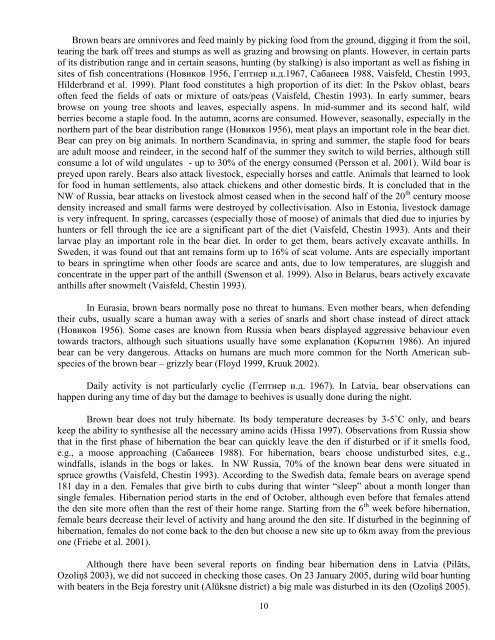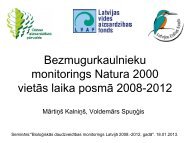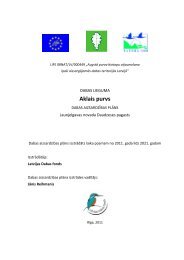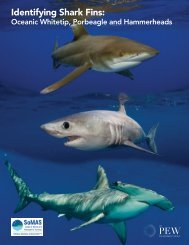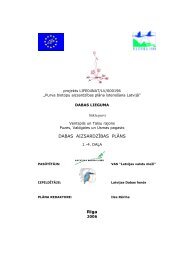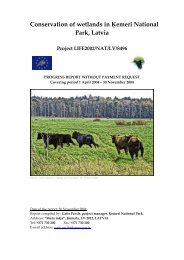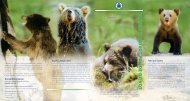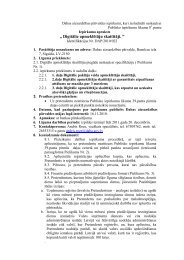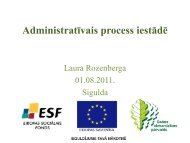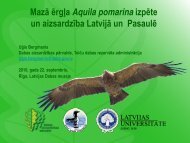Brown bear Ursus arctos - Dabas aizsardzības pārvalde
Brown bear Ursus arctos - Dabas aizsardzības pārvalde
Brown bear Ursus arctos - Dabas aizsardzības pārvalde
You also want an ePaper? Increase the reach of your titles
YUMPU automatically turns print PDFs into web optimized ePapers that Google loves.
<strong>Brown</strong> <strong>bear</strong>s are omnivores and feed mainly by picking food from the ground, digging it from the soil,<br />
tearing the bark off trees and stumps as well as grazing and browsing on plants. However, in certain parts<br />
of its distribution range and in certain seasons, hunting (by stalking) is also important as well as fishing in<br />
sites of fish concentrations (Новиков 1956, Гептнер и.д.1967, Сабанеев 1988, Vaisfeld, Chestin 1993,<br />
Hilderbrand et al. 1999). Plant food constitutes a high proportion of its diet: In the Pskov oblast, <strong>bear</strong>s<br />
often feed the fields of oats or mixture of oats/peas (Vaisfeld, Chestin 1993). In early summer, <strong>bear</strong>s<br />
browse on young tree shoots and leaves, especially aspens. In mid-summer and its second half, wild<br />
berries become a staple food. In the autumn, acorns are consumed. However, seasonally, especially in the<br />
northern part of the <strong>bear</strong> distribution range (Новиков 1956), meat plays an important role in the <strong>bear</strong> diet.<br />
Bear can prey on big animals. In northern Scandinavia, in spring and summer, the staple food for <strong>bear</strong>s<br />
are adult moose and reindeer, in the second half of the summer they switch to wild berries, although still<br />
consume a lot of wild ungulates - up to 30% of the energy consumed (Persson et al. 2001). Wild boar is<br />
preyed upon rarely. Bears also attack livestock, especially horses and cattle. Animals that learned to look<br />
for food in human settlements, also attack chickens and other domestic birds. It is concluded that in the<br />
NW of Russia, <strong>bear</strong> attacks on livestock almost ceased when in the second half of the 20 th century moose<br />
density increased and small farms were destroyed by collectivisation. Also in Estonia, livestock damage<br />
is very infrequent. In spring, carcasses (especially those of moose) of animals that died due to injuries by<br />
hunters or fell through the ice are a significant part of the diet (Vaisfeld, Chestin 1993). Ants and their<br />
larvae play an important role in the <strong>bear</strong> diet. In order to get them, <strong>bear</strong>s actively excavate anthills. In<br />
Sweden, it was found out that ant remains form up to 16% of scat volume. Ants are especially important<br />
to <strong>bear</strong>s in springtime when other foods are scarce and ants, due to low temperatures, are sluggish and<br />
concentrate in the upper part of the anthill (Swenson et al. 1999). Also in Belarus, <strong>bear</strong>s actively excavate<br />
anthills after snowmelt (Vaisfeld, Chestin 1993).<br />
In Eurasia, brown <strong>bear</strong>s normally pose no threat to humans. Even mother <strong>bear</strong>s, when defending<br />
their cubs, usually scare a human away with a series of snarls and short chase instead of direct attack<br />
(Новиков 1956). Some cases are known from Russia when <strong>bear</strong>s displayed aggressive behaviour even<br />
towards tractors, although such situations usually have some explanation (Κорытин 1986). An injured<br />
<strong>bear</strong> can be very dangerous. Attacks on humans are much more common for the North American subspecies<br />
of the brown <strong>bear</strong> – grizzly <strong>bear</strong> (Floyd 1999, Kruuk 2002).<br />
Daily activity is not particularly cyclic (Гептнер и.д. 1967). In Latvia, <strong>bear</strong> observations can<br />
happen during any time of day but the damage to beehives is usually done during the night.<br />
<strong>Brown</strong> <strong>bear</strong> does not truly hibernate. Its body temperature decreases by 3-5˚C only, and <strong>bear</strong>s<br />
keep the ability to synthesise all the necessary amino acids (Hissa 1997). Observations from Russia show<br />
that in the first phase of hibernation the <strong>bear</strong> can quickly leave the den if disturbed or if it smells food,<br />
e.g., a moose approaching (Сабанеев 1988). For hibernation, <strong>bear</strong>s choose undisturbed sites, e.g.,<br />
windfalls, islands in the bogs or lakes. In NW Russia, 70% of the known <strong>bear</strong> dens were situated in<br />
spruce growths (Vaisfeld, Chestin 1993). According to the Swedish data, female <strong>bear</strong>s on average spend<br />
181 day in a den. Females that give birth to cubs during that winter “sleep” about a month longer than<br />
single females. Hibernation period starts in the end of October, although even before that females attend<br />
the den site more often than the rest of their home range. Starting from the 6 th week before hibernation,<br />
female <strong>bear</strong>s decrease their level of activity and hang around the den site. If disturbed in the beginning of<br />
hibernation, females do not come back to the den but choose a new site up to 6km away from the previous<br />
one (Friebe et al. 2001).<br />
Although there have been several reports on finding <strong>bear</strong> hibernation dens in Latvia (Pilāts,<br />
Ozoliņš 2003), we did not succeed in checking those cases. On 23 January 2005, during wild boar hunting<br />
with beaters in the Beja forestry unit (Alūksne district) a big male was disturbed in its den (Ozoliņš 2005).<br />
10


